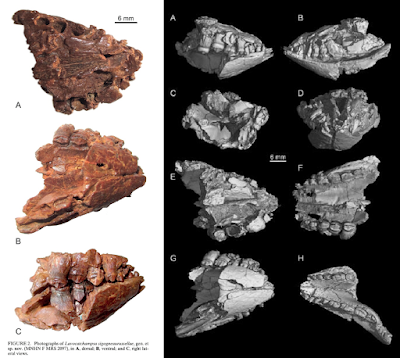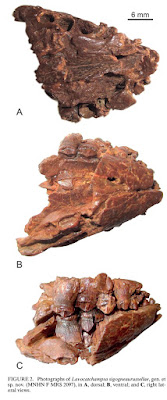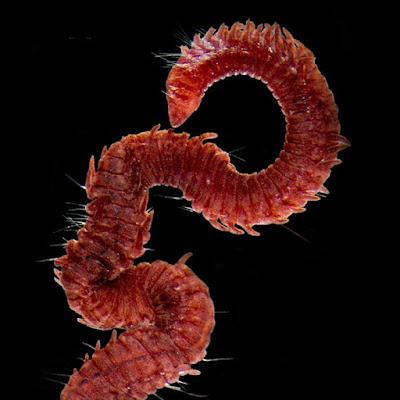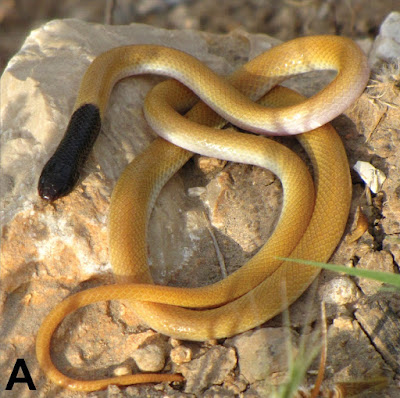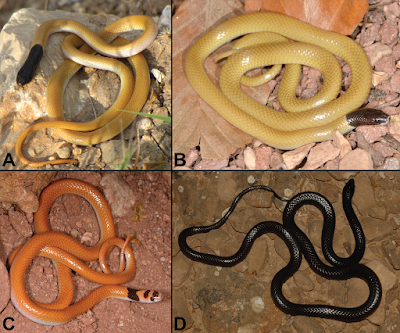[Most Recent Entries] [Calendar View]
Friday, November 10th, 2017
| Time | Event | ||
| 9:08a | [Paleontology • 2016] Lavocatchampsa sigogneaurusselae • A Miniature Notosuchian with Multicuspid Teeth from the Cretaceous of Morocco
Abstract Notosuchians from Cretaceous continental environments of Gondwana have developed an unexpected array of morphologies comparable to mammals and their extinct relatives. However, this exceptional diversity is unbalanced, with South America holding nearly three times the generic diversity of Africa-Madagascar. With the exception of the triconodonts and of a very specialized group, the Gondwanatheria, in none of these landmasses do mammals dominate, and as a result, the low notosuchian diversity in Africa-Madagascar appears to be an artifact of sampling. Here, we describe a new miniature notosuchian from the Albian-Cenomanian Kem-Kem Beds of Morocco filling this gap. Lavocatchampsa sigogneaurusselae, gen. et sp. nov., exhibits a new type of heterodonty with absence of maxillary and dentary caniniform dentitions and teeth that gradually become massive posteriorly, and possess a sharp elongate median carina flanked by two multicusped cingula. The occlusion pattern is revealed by computed tomography and scanning electron microscopy (SEM) and shows that the main component of jaw closure is vertical, and not horizontal as has been proposed in closely related forms. Phylogenetic analysis recovers the new taxon as part of a basal stock of Gondwanan ziphosuchians with close affinities to Candidodon itapecuruense, Malawisuchus mwakasyungutiensis, and Pakasuchus kapilimai. We revise the diagnosis of Candidodontidae, a clade characterized by a particular heterodont dentition recalling that of triconodont mammals. The recognition of this new clade confirms previous hypotheses of a vicariant vertebrate assemblage present on a continuous South American–African landmass. SYSTEMATIC PALEONTOLOGY CROCODILIA Gmelin, 1789, sensu Martin and Benton, 2008 MESOEUCROCODYLIA Whetstone and Whybrow, 1983 NOTOSUCHIA Gasparini, 1971 ZIPHOSUCHIA Ortega, Gasparini, Buscalioni, and Calvo, 2000 CANDIDODONTIDAE Carvalho, Ribeiro, and Avilla, 2004 LAVOCATCHAMPSA SIGOGNEAURUSSELLAE, gen. et sp. nov. Etymology:— The genus name honors the memory of the French paleontologist René Lavocat (1909–2007) for his contribution to vertebrate paleontology in Africa and in particular for the exploration of the Kem-Kem Beds and the discovery of its vertebrate fossil fauna. The specific name honors Dr. Denise Sigogneau-Russell, specialist on early mammals and with her husband, Dr. Donald Russell, for the acquisition of the specimen from Bruno Fectay. Jeremy E. Martin and France de Lapparent de Broin. 2016. A Miniature Notosuchian with Multicuspid Teeth from the Cretaceous of Morocco. Journal of Vertebrate Paleontology. 36(6); DOI: 10.1080/02724634.2016.1211534 Researchgate.net/publication/306929177_A | ||
| 9:31a | [Invertebrate • 2017] Cirrophorus species (Annelida: Polychaeta: Paraonidae) in the Sea of Marmara, with Description of A New Species
Abstract This paper deals with specimens of Cirrophorus collected from the depths ranging from 3 to 500 m in 2012 and 2013 in the Sea of Marmara, Turkey. Among the material, one new species and two already known species were found. The new species is mainly characterized by having long and clavate notopodial postchaetal lobes in the branchial region; red speckles near nuchal organs; and a very long branch of lyrate chaetae (4 times longer than the shorter one). A recently described species, Cirrophorus nikebianchii, was found at the majority of soft-bottom stations. All species found in the area were described and discussed. Keywords: Annelida, Paraonidae, new species, Cirrophorus, Sea of Marmara Deniz Erdoğan-Dereli, Melih Ertan Çınar and Ertan Dağlı. 2017. Cirrophorus species (Annelida: Polychaeta: Paraonidae) in the Sea of Marmara, with Description of A New Species. Zootaxa. 4347(1); 137–150. DOI: 10.11646/zootaxa.4347.1.8 Joachim Langeneck, Michele Barbieri, Ferruccio Maltagliati and Alberto Castelli. 2017. A new species of Cirrophorus (Annelida: Paraonidae) from Mediterranean organically enriched coastal environments, with taxonomic notes on the family. Journal of the Marine Biological Associations of the United Kingdom. 97; 871–880. DOI: 10.1017/S0025315417000935 | ||
| 2:54p | [Herpetology • 2016] Rhynchocalamus dayanae • An Integrative Systematic Revision and Biogeography of Rhynchocalamus Snakes (Reptilia, Colubridae) with A Description of A New Species from Israel Abstract Background The colubrid snakes of the genus Rhynchocalamus are seldom studied and knowledge of their ecology and life history is scarce. Three species of Rhynchocalamus are currently recognized, R. satunini (from Turkey eastwards to Iran), R. arabicus (Yemen and Oman), and R. melanocephalus (from the Sinai Peninsula northwards to Turkey). All are slender, secretive, mainly nocturnal and rare fossorial snakes. This comprehensive study is the first to sample all known Rhynchocalamus species in order to review the intra-generic phylogenetic relationships and historical biogeography of the genus. Methods We revised the systematics of Rhynchocalamus using an integrative approach and evaluated its phylogeography. The phylogenetic position within the Colubridae and the phylogenetic relationships within the genus were inferred using 29 individuals belonging to the three known species, with additional sampling of two other closely-related genera, Muhtarophis and Lytorhynchus. We analysed three mitochondrial (12S, 16S, cytb) and one nuclear (c-mos) gene fragments. Phylogenetic trees were reconstructed using maximum likelihood and Bayesian inference methods; the latter method also used to provide the first time-calibrated molecular phylogeny of the genus. We generated a nuclear network and carried out a topology test and species delimitation analysis. Morphological comparisons were used to differentiate among species and to describe a new species from Israel. The studied material was comprised of 108 alcohol-preserved specimens, 15 photographs, and data from the literature for the examination of 17 mensural, 14 meristic, and two categorical characters. Results The molecular results support Rhynchocalamus as monophyletic, and as having split from its sister genus Lytorhynchus during the Late Oligocene. The three recognized species of Rhynchocalamus comprise four independently evolving groups. The molecular results reveal that the genus began to diverge during the Middle Miocene. We revealed that the best-studied species, R. melanocephalus, is paraphyletic. A population, formally ascribed to this species, from the Negev Mountain area in southern Israel is phylogenetically closer to R. arabicus from Oman than to the northern populations of the species from Israel, Syria and Turkey. Herein we describe this population as a new species: Rhynchocalamus dayanae sp. nov. Discussion We identify four species within Rhynchocalamus: R. satunini, R. arabicus, R. melanocephalus, and R. dayanae sp. nov., the latter, to the best of our knowledge, is endemic to southern Israel. The onset of Rhynchocalamus diversification is very old and estimated to have occurred during the Middle Miocene, possibly originating in the Levant region. Radiation probably resulted from vicariance and dispersal events caused by continuous geological instability, sea-level fluctuations and climatic changes within the Levant region. Etymology. The specific epithet, “dayanae,” is named in honour of Professor Tamar Dayan, director of the Steinhardt Museum of Natural History at Tel Aviv University and curator of the Terrestrial Vertebrate Collection. This naming of the new species constitutes a special recognition of Professor Dayan by two of her former students (KT and SM) to acknowledge her immense contribution to the conservation of Israeli fauna, and her efforts in establishing the National Natural History Museum at Tel Aviv University, and in promoting taxonomy, conservation and ecology studies in Israel. Karin Tamar, Jiří Šmíd, Bayram Göçmen, Shai Meiri and Salvador Carranza. 2016. An Integrative Systematic Revision and Biogeography of Rhynchocalamus Snakes (Reptilia, Colubridae) with A Description of A New Species from Israel. PeerJ. 4:e2769. DOI: 10.7717/peerj.2769 | ||
| 4:43p | [Ichthyology • 2017] The “Lembeh Frogfish” Identified: Redescription of Nudiantennarius subteres (Smith and Radcliffe, in Radcliffe, 1912) (Lophiiformes: Antennariidae)
The “Lembeh Frogfish” or “Ocellated Frogfish,” a distinct antennariid, known for many years, especially among members of the dive community, and suggested by some to represent an undescribed species, is identified as Nudiantennarius subteres (Smith and Radcliffe). Unique in several ways—including reduced dermal spinules, the body appearing naked; illicium short, about half the length of the second dorsal-fin spine; second dorsal-fin spine unusually long and narrow, without a posterior membrane; pectoral lobe narrow, somewhat detached from the body; membranes between the rays of the paired fins deeply incised; and all pelvic-fin rays simple—the species is redescribed and figured below. Morphological and molecular analyses indicate a close relationship with the Sargassumfish, Histrio histrio. Theodore W. Pietsch and Rachel J. Arnold. 2017. The “Lembeh Frogfish” Identified: Redescription of Nudiantennarius subteres (Smith and Radcliffe, in Radcliffe, 1912) (Teleostei: Lophiiformes: Antennariidae). Copeia. 105(4); 659-665. DOI: 10.1643/CI-17-651 |
| << Previous Day |
2017/11/10 [Calendar] |
Next Day >> |
